
Bifrost: The Rainbow Bridge to Asgard Doomed to Collapse in Ragnarok
One of the most important elements of Norse mythology was the Bifrost. The Bifrost was the legendary shimmering rainbow bridge to Asgard, responsible for connecting the world of the gods with the world of the mortals. Its protector, Heimdall, was one of the most important of all the Norse gods. Together, they played a vital role in the apocalyptic battle of Ragnarok. So, how was a bridge so critical to Norse mythology, and what happened to the Bifrost rainbow bridge during Ragnarok?
What is the Bifrost Bridge in Norse Mythology?
Norse mythology was spread through word of mouth, so like most Norse mythology, Bifrost bridge details are thin, and rely on later retellings. Almost everything we know about the Bifrost comes from two poems in the Poetic Edda and two books in the Prose Edda.
For the most part, the two sources broadly agreed on the important details with only minor variations. Of the two, the Prose Edda went into much more detail and thus is our focus.
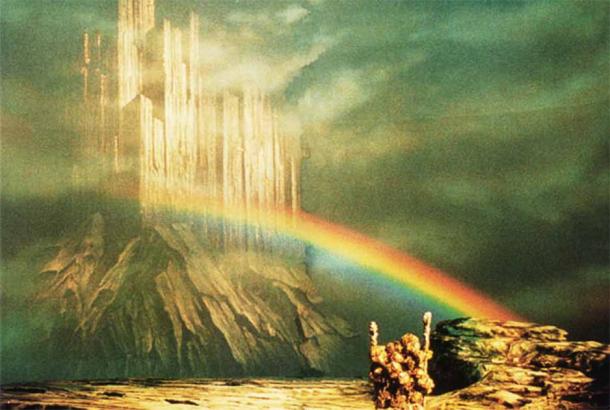
Interpretation of Bifrost bridge to Asgard in Wagner's Das Rheingold. Source: Richard Wagner and Otto Schenk / FAL-1.3
In the Poetic Edda, the Norse rainbow bridge Bifrost was described as the “best of bridges”. It was also described as burning with flames. Later, it was closely linked with Ragnarok, during which it was said to collapse. Sadly, this is all the detail available from the Poetic Edda.
The Prose Edda took those elements of the bridge (its craftsmanship, color, and destruction) and fleshed them out. In the text, King Gylfi, the first Scandinavian king, sought divine knowledge from the High (a pseudonym of Odin). Gylfi asked the high what connected Heaven and Earth. The High (Odin) mocked the king for not having heard the story before. Surely Gylfi had seen the rainbow bridge to Asgard before?
Odin, disguised as the High, stated that the Asgard rainbow bridge was made up of three colors and was immensely strong, as it had been built with great art and skill by the gods themselves. However, Odin said that despite its craftsmanship, the bridge was doomed to fall. Gylfi questioned this; how could something built by the gods be so fragile? The High responded that even the craftsmanship of the gods wouldn’t be able to stand up to the forces of Muspel giants when they stormed the bridge during Ragnarok.
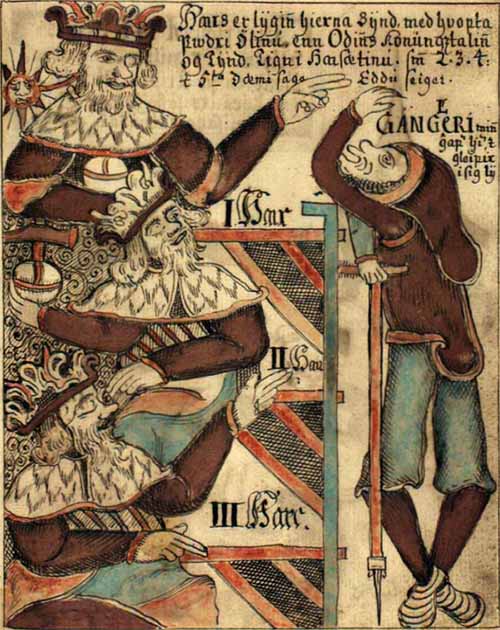
Odin in disguise mocking Gylfi’s ignorance of the Bifrost rainbow bridge (Public Domain)
According to the Prose Edda, the gods rode their horses across the Bifrost bridge every day to reach Uroarbrunner, the holy well where the gods held their daily court. The ancient king then asked if the Bifrost was burning, and the High said yes.
One of the three colors that made up the rainbow bridge to Asgard was red. The red represented burning fires. These fires held the ice giants, the Jotnar, at bay. Without the fires, the Jotnar would be able to lay siege to the heavens whenever they wished. The Bifrost acted not only as a bridge between the human tribes of Midgard and the Aesir gods of Asgard, but also as a line of defense.
- Where is Vanaheimr, Land of the Norse Nature Gods?
- Denizens of Valhalla and the Transient Afterlife of Norse Myth
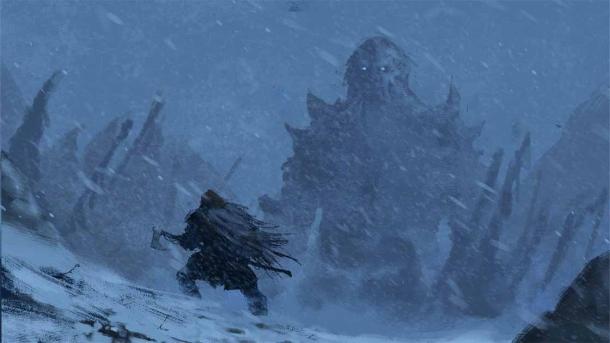
The Norse rainbow bridge named Bifrost acted as a defense against the Jotnar ice giants. Source: lobard / Adobe Stock
Heimdall and the Bifrost
In Norse mythology, Bifrost bridge had great significance. The Asgardians had many enemies, so the bridge between realms needed a guardian. That guardian came in the form of Heimdall.
Heimdall was the Norse god responsible for protecting the Bifrost rainbow bridge to Asgard. Depictions of Heimdall differ between sources, but there were a few constants. He was usually described as having been given the gift of foreknowledge, as well as great sight and hearing. Simply put, he was the ultimate watchdog. He could see threats coming from any direction, including the future.
Heimdall lived within a fortress known as Himinbjorg. Himinbjorg was located at the end of the Bifrost, where the rainbow bridge joined with Asgard. Heimdall was often described as the palest or whitest of the Asgardian gods. He carried a great sword, the horn Gjallarhorn, and rode a golden-maned horse named Gulltoppr. His origins differed between tales, but it was usually said that he was a son of Odin with nine mothers.
It was Heimdall’s job to guard the Bifrost against the Jotnar. In Norse mythology, Ragnarok was viewed as preordained, so Heimdall’s job was largely one of putting off the inevitable.
- Heimdall, Watchman of the Gods, Will Sound the Horn as Ragnarok Approaches
- Ragnarok: Norse Account of Strange & Wonderful Land Doomed to Destruction – Part I
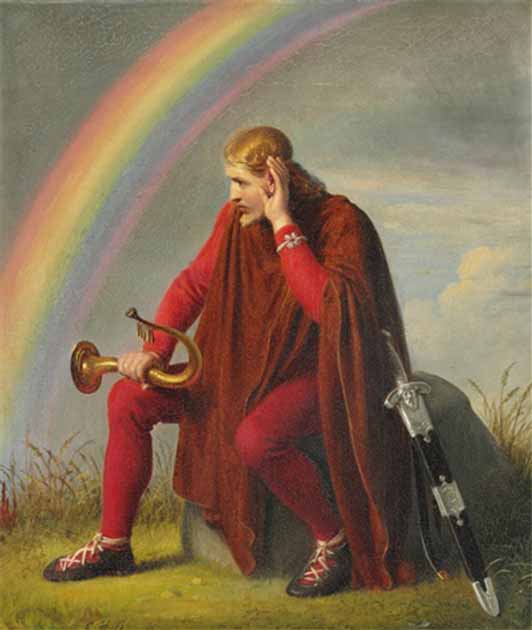
Heimdal listening next to Bifrost bridge. Painting by Constantin Hansen, 1860 (Public Domain)
The Bifrost Bridge, Heimdall and Ragnarok
In Norse mythology, the gods were all doomed to fail. It was fated that eventually Ragnarok would come, and the Bifrost bridge would fall. Although it was Heimdall’s job to protect the Bifrost from the Jotun, he always knew he would fail.
It was said that one day the forces of chaos would march against the gods of Asgard. Loki would reunite with his children Fenrir, Hel, and the world serpent Jormungandr. Then, the spirits of the underworld, the ice giants, and the forces of Muspelheim would join them.
It was Heimdall’s job to blow the mighty Gjallarhorn and warn the gods. Then the Asgardians, joined by the spirits residing in Valhalla, would ride across Bifrost, Asgard rainbow bridge, to battle.
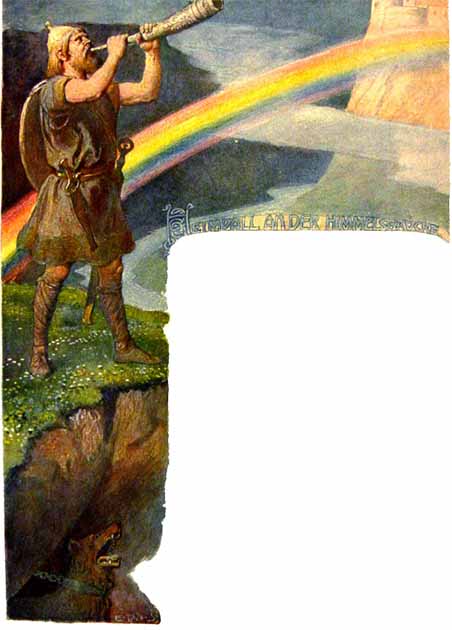
Heimdall stands by the Bifrost bridge to Asgard, blowing into Gjallarhorn, to call the gods to the battle of Ragnarok. Illustration by Emil Doepler, 1905 (Public Domain)
Odin was doomed to kill and be killed by Fenrir, and Thor to be kill and be killed by Jormungandr. Heimdall and Loki would also end each other’s lives. Heimdall’s stewardship of the Bifrost bridge would end when it was either destroyed by the forces of Muspelheim, or according to some sources, collapsed under the weight of the Asgardian forces.
Conclusion
The Bifrost bridge and Heimdall represent the core theme of predestination in Norse mythology. Heimdall spent his life protecting the Bifrost from the Jotun forces, knowing full well that he was destined to fail.
Although all the gods knew their final fates, Heimdall was perhaps the most tragic tale of all. Thanks to his gift of foreknowledge, he knew better than anyone that his efforts would ultimately be futile.
However, it must be remembered that the Norse story of Ragnarok is not intended to be a tragic one. Even though the nine realms, the gods, and even the Bifrost itself were all fated to annihilation, it was said that a new Earth would rise from the ruins. Ragnarok was a tale of both destruction and creation.
Top image: The Rainbow Bridge by Hermann Hendrich. Source: Archivist / Adobe Stock
By Robbie Mitchell
References
Bifrost- Mythical Rainbow Bridge. 2022. History of Bridges. Available at: http://www.historyofbridges.com/mythological-bridges/bifr%C3%B6st/
Lindow, J. 2001. Norse Mythology: A Guide to the Gods, Heroes, Rituals, and Beliefs. Oxford University Press.
Orchard, A. 1997. Dictionary of Norse Myth and Legend. Cassell
















Comments
Rainbow bridge is most likely a metaphor for the Nothern Lights, which would have vanished upon the sudden emergence of the Ice Age (nuclear winter), circa 115k BC, when all went dark for maybe hundreds of years or more. Plato wrote about Atlantis during the Ragnarok event, but a zero was removed from his timeline.
Nobody gets paid to tell the truth.